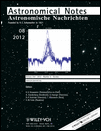The Bochum survey of the southern Galactic disk: I. Survey design and first results on 50 square degrees monitored in 2011
Abstract
We are monitoring a 6° wide stripe along the southern Galactic disk simultaneously in the r and i bands, using a robotic 15-cm twin telescope of the Universitätsternwarte Bochum near Cerro Armazones in Chile. Utilising the telescope's 2.7° field of view, the survey aims at observing a mosaic of 268 fields once per month and to monitor dedicated fields once per night. The survey reaches a sensitivity from 10m down to 18m (AB system), with a completeness limit of r ∼ 15.5m and i ∼ 14.5m which – due to the instrumental pixel size of 2.″4 – refers to stars separated by >3″. This brightness range is ideally suited to examine the intermediately bright stellar population supposed to be saturated in deep variability surveys with large telescopes. To connect to deep surveys or to explore faint long term variables, coadded images of several nights reach a depth of ∼ 20m. The astrometric accuracy is better than 1″, as determined from the overlap of neighbouring fields. We describe the survey design, the data properties and our procedures to derive the light curves and to extract variable stars. We present a list of ∼2200 variable stars identified in 50 square degrees with 50-80 observations between May and October 2011. For bright stars the variability amplitude A reaches down to A ∼ 0.05m, while at the faint end variations of A > 1m are detected. About 200 stars were known tobe variable, and their amplitudes and periods – as far as determinable from our six month monitoring – agree with literature values, demonstrating the performance of the Bochum Galactic Disk Survey (© 2012 WILEY-VCH Verlag GmbH & Co. KGaA, Weinheim)




